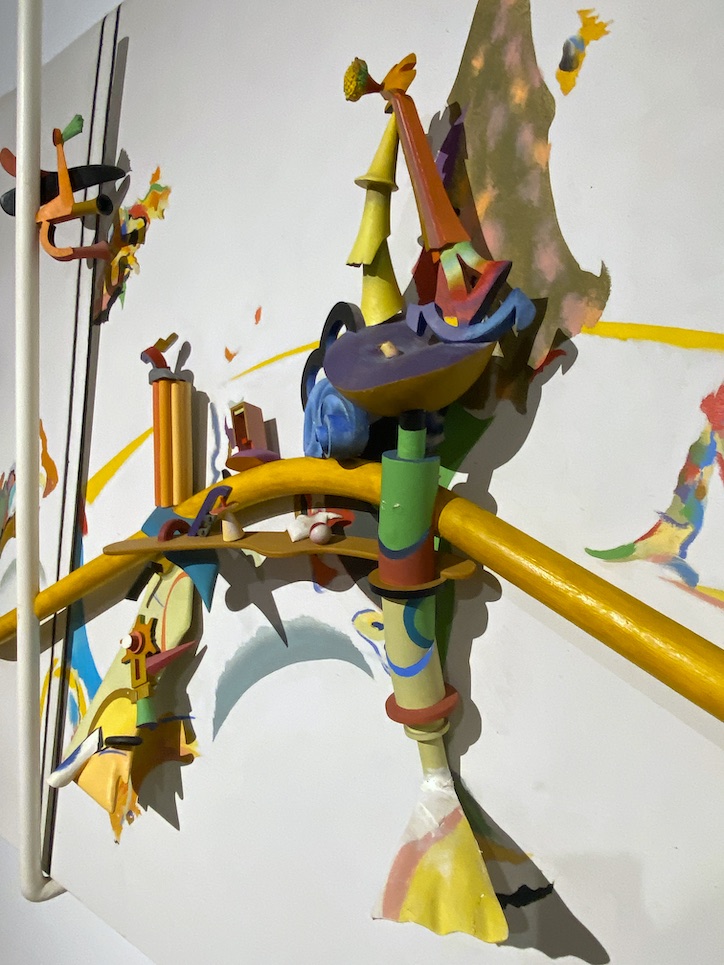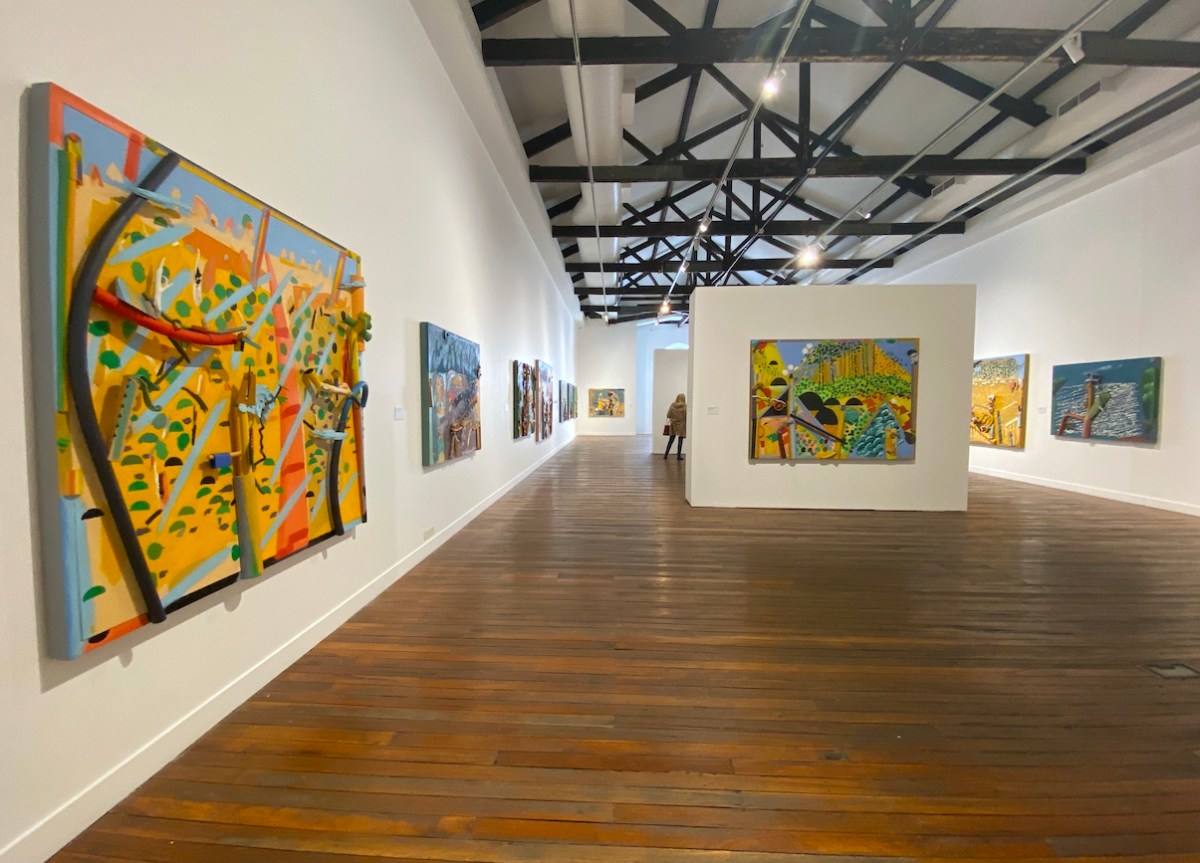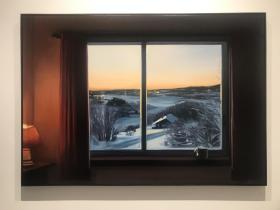Some years back, the paintings and prints of Colin Lanceley (1938–2015) had fallen out of fashion, often picked up on the secondary market circuit.
‘Taste’ is a strange thing when it interrupts art history. But this survey exhibition is testament to the sticking power of Lanceley’s role in shaping a unique Australian language, despite the erratic waves and troughs of fashion.
Colin Lanceley: Earthly Delights is a major retrospective, fittingly at the National Art School. Lancelely was a student there in the 1950s. And while he lived abroad during the 60s and 70s, he returned to Australia in the 80s to pick up at NAS – this time as a teacher – and later as Chairman of the Advisory Board and Fellow.
Curated by Sioux Garside, and supported by Lanceley’s wife Kay, the exhibition maps out five decades of making, confirming his creative legacy as ‘a modernist trailblazer’, as described by the gallery.
Walking into the gallery, one unfortunately enters the exhibition at its half-way point due to current building works across the NAS campus. If you are a stickler for chronological surveys, then throw the blinkers on and head down the gallery to the start – to a painting from 1961-62, Byzantium, when Lanceley, with fellow artists Mike Brown and Ross Crothall, formed The Imitation Realists (or Annandale Realists, 1958-62).
They are said to have triggered an embrace of assemblage and collage in Australian art with an urban flavour. While the trio burned bright, and then went their own ways, Lanceley continued to push an assemblage genre, making it his own with a high chroma vigour.
Viewers can see that starting point in Byzantium, with Lanceley’s use of paint tin lids (he worked as a colour mixer at the Dulux paint factory at the time), which eventually expanded to other found objects, in particular timber elements.
In 1963, he and artist friend Robert Klippel found a cache of wooden patterns once used for machine parts from the Goldsborough Mort building in Balmain. Those cogs and forms found their way into a suite of five wall-based collages that would shape his career for the next 50 years.
It is a rare treat to see these together along with other works of that period, and how, so early in his career, Lanceley was already pushing the definitions of painting.
He once said of his process: ‘I found that merely manipulating paint at the end of the arms was not enough.’
Collage was becoming more and more important to me. It became more than just a working process – it became a philosophy of life…
Colin Lanceley, 1987
But Australia lost Lanceley for a period. He choofed off to London in 1964 after winning the Helena Rubenstein Travelling Art Scholarship. The exhibition is understandably a little thinner representing this part of his career – a significant chapter with Lanceley teaching at the Chelsea School of Art and showing with Marlborough Galleries.

Highlights from this period in the exhibition are Suddenly last summer (1975), a more pared back round work on a white background making the vibrant gestures pop, and The petrified forester (1975-76).
He returned back to Australia in 1981. I remember as a young gallerist visiting Lanceley’s Surry Hills warehouse home / studio packed to the gills with ‘stuff’. It is not surprising that he was described as a ‘creative forager’. There was no hierarchy between collected artefacts, urban detritus or bush branches.
Moving upstairs that next chapter in his career, where Lanceley’s signature technicolour assemblages continue to move beyond mere sensory pleasure, take further form and refinement, finding a balance between the natural and the painted.
These elements aren’t just ‘stuck’ on; they became activated painted lines that add a spatial quality – without compromising painting or sculpture as genres. The scale of Lanceley’s work is repeatedly confident; there is little evidence of uncertainty.
Read: Exhibition review: Luke Sciberras, Side of the Sky
From the 80s to his death in 2015, Lanceley found a new life in the light and colour that Australia offered, and they were productive decades. In the cathedral-like space of the gallery’s upper level, visitors come face-to-face with that colour and light; and with landscape, music, poetry, and antiquity.
A great example is the work Jazz (1980) where the elements writhe and pop to a beat, or South coast from Coalcliff Mine to D H Lawrence (1987), a painting that demonstrates the layers and levels of narrative within many of Lanceley’s work, the pared down elements like a Haiku that hits the mark.
At points this exhibition feels overwhelming, and yet on mass, the viewer starts to learn how to read these works beyond their initial decorative punch – not that Lanceley ever shied from the ‘decorative’ tag; indeed he embraced it with a Matisse-esq passion.
What is clear across this show is Lanceley’s unwaivering vision. For an artist to continue to refine and extend a very personal visual language to this level is incredibly admirable, and to position this cross-career look in an art school is particularly fitting, especially in a time when ‘external noise’ can be so disruptive to an artists’ making.
We have become so screen-driven, so conceptually-driven, that it is a refreshing pause – as if to recalibrate our viewing sensibilities, and give renewed vigour to the assemblage genre.
This retrospective assures that one of Australia’s most original artists of his generation – and still to this day – will not be forgotten, or relegated to ‘yesterday’s taste’.
The exhibition demonstrates Lanceley is a champion worthy of the chapter he holds in Australian art.
Colin Lanceley: Earthly Delights
The National Art School, Darlinghurst
24 June – 13 August, 2022
A publication accompanied the exhibition.





